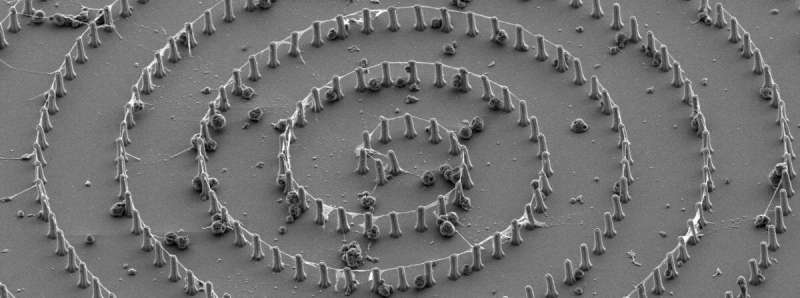Carbon nanotubes open new horizons for neuroscience: controlling neural cell outgrowth

Researchers of the Microelectronics Research Unit (MIC) at the University of Oulu, in collaboration with Tampere University, have demonstrated that carbon nanotubes can be used to control the direction of neural cell growth.
Carbon nanotubes are extremely tiny cylinders that are stronger than steel and have exceptional conductive properties. By creating carbon nanotube pillars with optimal dimensions, the researchers can control the directions in which neural cells grow, enhancing the formation of a complex and oriented neural cell network.
The study, titled "Carbon nanotube micropillars trigger guided growth of complex human neural stem cells networks," is published in Nano Research.
Neuroscientists study the structure and function of the nervous system from the cellular and molecular biology to nervous system diseases such as Alzheimer's and spinal cord injuries. Although advances have been made in studies related to neural disorders and novel strategies for treatment, several challenges remain in this field. To enhance the progress in neuroscience, nanotechnology has been playing an important role.
Carbon nanotubes have been studied for over 25 years with significant contributions to nanotechnology. The vast majority of electronic devices such as computers and mobile phones include carbon nanotubes in their components. The most popular use of carbon nanotubes is structural reinforcement, as seen in bike frames and tennis rackets, for example.
"My research focus has become very multidisciplinary. As a physicist by background, I have applied material science strategies to study biological systems. During my first postdoctoral studies, I worked two years at the former Department of Anatomy and Cell Biology at the University of Oulu. When I started to work with Prof. Krisztian Kordas, I got the opportunity to learn more about carbon nanotubes. I got fascinated by the idea of exploring their properties for medical applications, and started to apply for funding within this topic. This paper is an outcome of one of my projects named InjectGuide, funded by the Academy of Finland," says docent Gabriela Lorite Yrjänä, leading research in this project.
The ability to control how the neural cells grow opens new perspectives in two important aspects of neuroscience. The first is to create new types of microelectronics arrays to study cell network electrophysiology. The current microelectronics arrays used to understand how neural cells communicate are built in 2-D, while in the human body, they grow in a much more complex 3-D environment. The results of this paper demonstrate that carbon nanotube micropillars can be used as templates to create 3-D microelectronics arrays. This work is performed in collaboration with docent Susanna Narkilahti and the postdoctoral researcher Laura Ylä-Outinen from Tampere University, who has the expertise of the electrophysiology measurements and neural cells.
A second potential application of these findings is related to new strategies for the treatment of spinal cord or peripheral nerves injuries. The challenge in these types of injuries is to grow neural cells in very specific direction.
"Our results provide evidence that by arranging the carbon nanotube micropillars at specific spacing, the neural cell outgrowth can be directed in any desired geometry. The drawback of this study for clinical application is the fact that the carbon nanotubes are attached to a rigid surface. Next, we are aiming to transfer this knowledge to complex 3-D structures. This work is carried out together with Professor Minna Kellomäki from Tampere University, who has the expertise in hydrogels for tissue engineering. The collaboration in multidisciplinary research is extremely important to make relevant progress in applied science," says docent Gabriela Lorite Yrjänä.
Beyond the field of neuroscience, docent Gabriela Lorite Yrjänä and her team are also seeking to use carbon nanotubes to enable cartilage repair.
More information: Gabriela S. Lorite et al. Carbon nanotube micropillars trigger guided growth of complex human neural stem cells networks, Nano Research (2019). DOI: 10.1007/s12274-019-2533-2
Journal information: Nano Research
Provided by University of Oulu




















